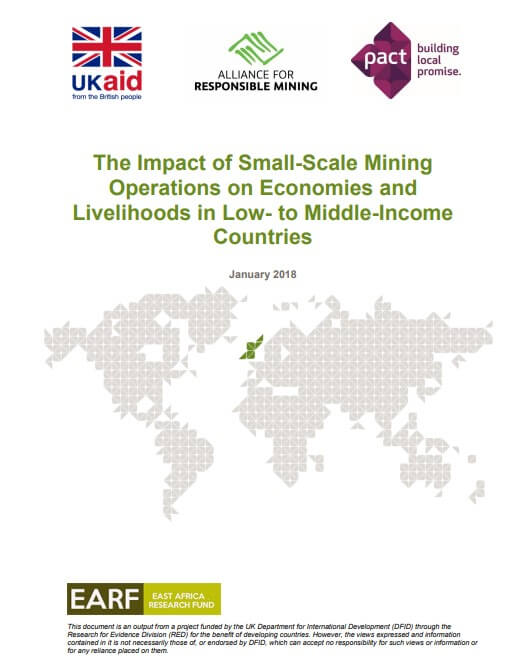 Full reports of the research are now available on ARM’s website.
Full reports of the research are now available on ARM’s website.
Pact and the Alliance for Responsible Mining (ARM) formed a partnership to undertake the East Africa Research Fund (EARF) study on Understanding the Economic Contribution of Small-Scale Mining in East Africa between June 2016 and March 2018.
The research provides findings on ASM in Kenya, Uganda and Rwanda and highlights the potential of the sector to promote inclusive economic growth and poverty reduction.
This research had three main objectives:
- Conducting an overarching synthesis to understand the impact of ASM operations on economies and livelihoods in low to middle income countries, and explore the implications for three case study countries in East Africa (Kenya, Uganda and Rwanda);
- Mapping the scale of ASM operations in these three countries and assessing the current and potential national and sub-national economic contribution of the sector and policy approaches to maximise benefits for people living in poverty;
- Making key recommendations to maximise the economic contribution of the ASM sector to promote inclusive and sustained growth, both at a national level and for relevant sub-national geographic areas.
Summary of interesting findings
- Global employment figures for the ASM sector are estimated in the range of 40 million miners (Kenya: 140,000; Rwanda: 65,000; Uganda: 300,000), even if the knowledge about informal ASM is limited. The prevalence of ASM correlates with countries’ economic development level.
- ASM produces a crucial source of much-needed rural employment and a means to reduce rural-urban migration.
- Income of artisanal miners is generally higher than income from other available rural occupations and most of these incomes are spent within the local economy.
- In conflict-affected and high-risk areas, control over ASM is a main target for armed groups and criminal networks. Artisanal miners are the victims, not the perpetrators of such conflicts.
- Traceability and due diligence aim to benefit the ASM sector but, as an undeniable paradox, at the cost of the ASM sector and the mineworkers.
- ASM operates predominantly in the informal sector and its economic contribution is not accounted for in national statistics. The inclusion of ASM in the formal economy would increase the GDP of the countries by several percent.
- Formalisation of mining rights needs a focus on ASM organisations. Formalisation and organisation of the ASM sector are indivisible and mutually reinforcing.
- For ASM organisations, legislation needs to incorporate the core elements of mineral rights. These rights include exclusivity rights, rights of transfer and upgrade, successive permit renewals, right to process minerals and the right to commercialise products at market price.
- ASM formalization needs to be accompanied by programmes to mitigate the activity’s negative impacts and to improve its social and environmental performance.
- ASM formalisation is possible with political will and occurs even faster if supported by market incentives.
Read the Overarching Synthesis Report
In the country case studies (Kenya, Rwanda and Uganda) the research accessed two regions and two minerals in depth.
Read the Kenya report
Highlight: ASM gold mining at the assessed mining village Osiri injects USD 1.9 million per year into the local economy. At the Migori district level, ASM gold mining generates USD 37 million per year and at the national level USD 225 million per year. Gemstone mining in Taita Taveta generates a production value of USD 120 million per year, of which roughly USD 50 million per year is spent locally. It is estimated that ASM gold and gemstone mining nationwide together generate a foreign exchange influx into the country in the range of USD 500 million per year.
Read the Rwanda report
Highlight: Responding to the challenge of international conflict minerals legislation, Rwanda has made significant progress towards formalising its ASM sector. The study estimated that artisanal and small-scale miners contributed approximately USD 39.5 million in the form of expenditures to the local economies in 2015. One cassiterite/tantalite mine (run by a cooperative) and one wolframite mine (under the umbrella of a company) were assessed and in both cases, the major part of the generated production value remained in the communities as income for miners and subcontractors. Government revenues from the formalised ASM sector are significant and the sector contributes almost 20% of the country’s exports.
Read the Uganda report
Highlight: In one of Uganda’s poorest region, Karamoja, artisanal gold mining provides 22,500 miners with an annual income that is significantly above the gross national income (GNI). Gold production in Karamoja is conservatively estimated at 845 kg per year, representing a LBMA market value of USD 36 million. In the wider Kampala area, more than 90,000 informal clay miners and brick-makers produce about 8 billion bricks, generating a production value in the range of USD 500 million per year. If ASM would be included in the formal sector, Uganda’s gross domestic product (GDP) would increase by 5%.

